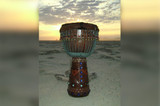Didgeridoo Care and Maintenance Tips
Like any instrument, didgeridoos require some upkeep. If you would like to enjoy your didgeridoo for many years, it is best to look into didgeridoo maintenance and care. They are not difficult to maintain, but you must be willing to put in the time and effort in order to enjoy the rewards.
Like any wood instrument, didgeridoos may fall victim to cracks, so it pays to remain mindful of how often the instrument is played. Serious didgeridoo players may have dozens of them available so that no one instrument is put under the strain of constant playing. A new didgeridoo must be broken in, allowing it an opportunity to get used to its new environment. When you first receive your instrument, only play it for a few minutes at a time, as the moisture in your breath will affect the wood.
Temperature and humidity levels in the environment also affect the wood of your didgeridoo, so make sure you protect it from extremes. Like drums, you want to shield your didgeridoo from really hot and dry atmospheres. For storage and transportation, look into acquiring a hard case or sealable tube. Didgeridoo maintenance and care can become more technical, with the use of humidifiers and hygrometers, but that is not always necessary. Your main concerns will likely stem from a desire to protect against cracks, so make sure you allow your didgeridoo to dry out on the inside after playing.
You may find various cleaning advice for your didgeridoo, so read any information that comes from the manufacturer, do your own research, and find what works best for you and your instrument. Many sources recommend washing the inside of the didgeridoo with water every now and then. This follows along with Aboriginal customs. In the past, didgeridoos might have been kept moist in creeks or waterholes to keep them from cracking or shrinking. With beeswax seals and the like, some didgeridoo lovers would say to never allow water to touch your instrument. Perhaps it is a matter of preference.
Many sealants, oils, and other products are available for normal maintenance and care, but it is good to understand how they affect the sound. Never apply oils and the like to the outside of didgeridoos decorated with ochre; colors may change or disappear completely. These days, with many didgeridoos sealed on the inside, there is not much work for you to do as long as you establish a regular routine with regard to your didgeridoo maintenance and care.
Recent Posts
-
What is the Best Size Djembe for Beginners?
If you're new to the world of percussion and interested in learning the djembe, you're in for a t …16th Jul 2024 -
The Benefits of Becoming a Drumming Teacher: Transforming Passion into Profession
Why become a drumming teacher? Becoming a drumming teacher is an excellent way to share your pas …22nd May 2024 -
What Makes the Djembe Drum a Spiritual Instrument in African Music?
Origin and history of the Djembe drum The Djembe drum originates from West Africa and holds sign …16th May 2024



